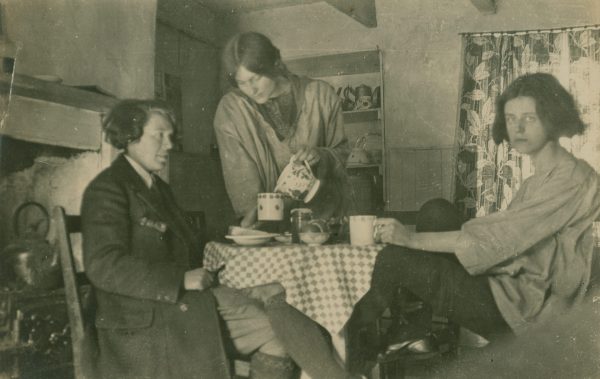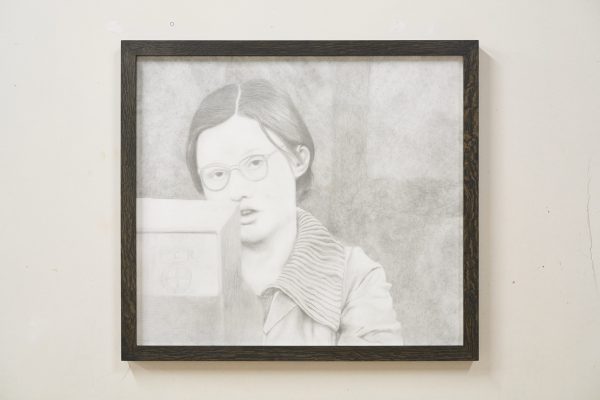There’s a moment in Laura Kaye’s underrated novel English Animals when the protagonist Mirka, sitting in the village bar with her married lover, notices that they can caress fairly openly by virtue of their both being women. ‘Nobody was looking,’ she thinks to herself. ‘I realised they probably thought we were only two friends who liked to touch each other a lot when they talked.’ While the obliviousness of those around them is conducive to their affair, this moment encapsulates a problem queer women frequently encounter when searching for their counterparts in print and on screen. So little attention is paid to women’s relationships with each other that amity and eroticism are too often confused, to uncomfortable effect: such blurring shows the lack of significance regularly attributed both to lesbianism and to deep female friendship. When I was younger and first looking for media that represented my own experiences, this inchoate model of relationships used to make me cautious about ever getting too close to my female friends, in case they or I became similarly confused. I was already lonely without a queer community, and this caution made me even lonelier.
But in recent years I’ve begun to notice an increase in art by women about female friendship, which I hoped would help to make clearer the difference between these two kinds of relationship. Perhaps, I thought, if we had more iconic examples of non-romantic, non-erotic friendships, representations of things I might do on a date with another woman — like holding her hand, or kissing her — wouldn’t be so readily coded as just being really great pals. But on reading and watching works feted for their depictions of female friendship, I found that even writers I admired seemed determined to shoehorn in eroticism as a way of showing how close two women are. I was disappointed by the passage in Zadie Smith’s NW where Natalie gets given a vibrator by Leah, whose past as a not entirely straight woman feels tacked on amid much more thoroughly explored class- and race-based discomfort. The section of Elena Ferrante’s My Brilliant Friend in which Lenu watches Lila in the bath offers a transgressive thrill that isn’t justified by any later use for character development. Early on in Noah Baumbach’s film Frances Ha, the eponymous heroine suggests she and her friend Sophie should put one another before romantic partnerships with men. Frances jokes that ‘we’re like an old lesbian couple that doesn’t have sex any more’, which seems a way to summon the possibility she might desire her friend in order to negate it. Frances Ha — its directors described the process of plotting it as deliberately akin to a rom-com — has garnered praise from some quarters for its potential to be read as queer, but the film never actually engages with queerness explicitly, except to dismiss it in this throwaway line.
The more I read and watched, the more I found that many otherwise wonderful depictions of female friendship run up to the boundary-line of lesbian eroticism, touch it, then run back again, having shown the audience that ‘x and y are so close they’re almost like lesbians’. It’s not clear whether these scenes get written in for want of any better way to demonstrate intimacy, or to keep queer consumers interested while not scaring off straight ones (a practice often referred to as ‘queerbaiting’ when it happens on TV). Such depictions of friendship revel in the frisson of taboo sexuality without doing the harder work of taking lesbian eroticism seriously. In my experience, one party in a friendship desiring the other has a significant effect on the friendship, whether or not that desire is acknowledged. It is beyond demoralising to see your identity rendered only as a sexy subtext or a minor plot point.
There are recent novels about women’s erotic interest in one another which have been rather better at parsing the differences between the two phenomena, though I have found some of the critical response to these puzzling at best. Sally Rooney’s 2017 novel Conversations with Friends was bundled into the larger cultural trend of art about female friendship: the Telegraph described it as ‘a piercingly unsentimental take on the modish subject of female friendship’, while Alexandra Schwartz in the New Yorker writes that Frances is ‘more than a little attracted to’ her ex-girlfriend, Bobbi. I was baffled as to how they could have managed to miscategorise one of the central relationships in the book. Rooney herself has pushed back on this reading. ‘I realise “female friendship” is having a cultural moment right now,’ she said in an interview. ‘For me, it sits at a strange angle to my own book, because Bobbi and Frances are not really “female friends”; they’re ex-girlfriends, and their relationship is, at least for me, marked by a definite undercurrent of sexual tension.’ The continual conflation of female friendship with female-female eroticism has historically allowed art about queer women to fly under the censors’ radar (see Mrs Dalloway), but this has also contributed to the lack of consideration given by critics to explicitly lesbian relationships in contemporary media. I find it slightly easier to see how this mistake has been made with Conversations with Friends when I recall how the significance of the queer relationship is initially side-lined by the main character herself. Frances — preoccupied by her affair with Nick, an older married man — repeatedly fails to notice Bobbi’s attempts to win back her affection unless she needs Bobbi’s help or sympathy. There’s a lack of visibility even within their relationship; when Bobbi finally confronts Frances, it’s over her wilful blindness.
Occupying a position somewhere between love and friendship is not always a disaster. Some of my most valued relationships with other women remain in or have passed through this terrain. The poet and essayist Adrienne Rich wrote that ‘if we consider the possibility … that all women exist on a lesbian continuum, we can see ourselves as moving in and out of this continuum, whether we identify as lesbian or not.’ But because women are seldom taught to enforce their own boundaries, the continuum is a dangerous place if you move up and down it without honesty and a shared understanding that you could do real damage to each other. For that to work, you both need to know who you are.
If Conversations with Friends serves as a warning against ignoring the nature of other women’s feelings, Olivia Sudjic’s 2017 novel Sympathy warns against ignoring your own. When I realised this was a novel about one woman becoming obsessed with another, I was concerned it would be another iteration of the lesbianism-as-narcissism trope, to be found everywhere from LeFanu’s Carmilla to Lynch’s Mulholland Drive. Sudjic cleverly subverts the trope by having Alice look for herself in another woman, only to be faced with the revelation that ‘I am not Mizuko … If I have hit on a moral, it is this: the body is our natural barrier.’ Alice has recently graduated from Oxford and moved to New York without any plans for what she might do there. She has no friends and very little idea of who she is or what she wants, beyond wandering the streets aimlessly taking pictures on her phone. Mizuko is nine years older than Alice, exquisitely beautiful and on her way to becoming an established writer. Alice stalks Mizuko online, teaching herself how to be the perfect foil and companion, while ignoring her dying grandmother. She finds it hard to believe Mizuko had a past before they met: she considers her to be ‘my beautiful quantum self’.
Sympathy has also been reviewed as a novel as about friendship, but it seems to me that Alice’s refusal to consciously see her fixation with Mizuko as sexual is a large part of what drives her to behave so destructively. Alice simultaneously overidentifies with Mizuko and desires her, punishing Mizuko for not staying close enough. In stark contrast to painful encounters with her boyfriend Dwight, Alice is in raptures just sitting next to Mizuko: ‘I felt bliss expanding from my chest and sliding down into the rest of my body, collecting my shoes like warm pools of butter despite the air conditioning.’ Alice continually replays their lone, drunken kiss in her mind, ‘this one moment, hyperreal, which rends everything in two’. ‘I did not think I was gay,’ Alice tells us, but this is a character so unreliable that she faked her father’s suicide note for herself to ‘find’ in the attic. Alice can’t admit she wants to fuck Mizuko, but she can fuck her life up and get off on watching it fall apart as part of her malignant quest for closeness. Seen from outside, Alice would just have been a clichéd lesbian stalker, but Sudjic makes us privy to Alice’s denial and shows us the havoc that denial wreaks on a person’s life and the lives of the people around her. I loved this book because it refutes the fallacy that all desire for closeness is the same, by making Alice herself cling to that belief and take it to a terrifying conclusion.
Mirka, the narrator of English Animals, knows full well that not all desire for closeness is the same, but her lover Sophie internalises the misconception in order to continue leading a double life. This is a book about knowing yourself and having to wait for everyone else to catch up – and how it feels to be the one who gets rendered invisible. This novel’s queerness cannot be denied or misread or glossed over, which may also explain why it’s been comparatively critically ignored. Mirka has already had a disastrous secret relationship with her English teacher back in Slovakia, been discovered and had to flee to London. Lonely and overworked, she answers an advertisement to work in a rural B&B run by a married couple, Richard and Sophie, two posh borderline alcoholics who hate each other. Unfortunately, Sophie is also very attractive and Mirka finds it impossible to resist her advances. Mirka thinks they are having a clandestine affair, but later discovers that Richard knows and doesn’t consider her to be a threat. She is riven with guilt, both for sleeping with another man’s wife and for wanting him to take her incursion as gravely as she takes it.
English Animals is the book I have been waiting for for years without knowing it. No other novel I have read portrays so well the hurt and confusion caused by women who deliberately elide the difference between friendship and something more, and then pretend those two things are the same. How they make you feel culpable for thinking of them as more than a friend when they think of you as an experiment. How you come to resent their entitlement to retreat back into the straight world, while also wanting to offer solidarity for their suffering at the hands of misogynist men. How the woman who wants to make you the sole bearer of your shared knowledge does this because she has more shame than she can hold. When Sophie’s family descends on Richard and Sophie for Christmas and start treating Mirka like the servant she technically still is, it becomes clear that Mirka will never be part of the family, only Sophie’s dirty secret. ‘I had not seen Sophie how she really was. She wanted everything. She wanted everyone to love her… But sometimes you had to make a choice.’ In the end, Sophie chooses respectability, and Mirka has too much self-respect to stay invisible, even for love. She chooses to break her own heart by leaving Sophie and returning to London, rather than staying where she is and having it broken slowly by Sophie’s denial.
English Animals dares to venture that it’s better to be lonely than to accept less than you deserve. It shouldn’t feel so radical to read a novel that ends with an openly queer narrator walking away from someone who doesn’t take their relationship seriously, but it does. Mirka might not get the girl this time, but she has the self-knowledge to ask for something more than friendship, and to call that thing by its real name. English Animals has taken another step away from the closet and into the daylight. I hope there will soon be many more novels to join it out there.




